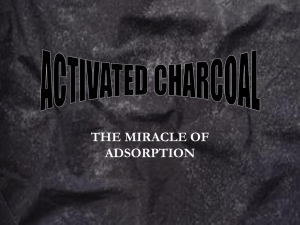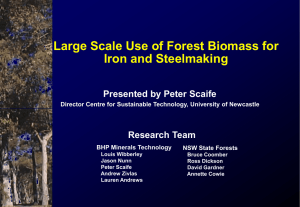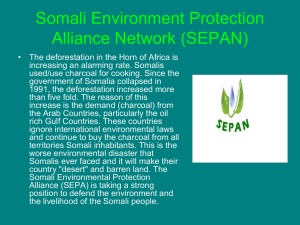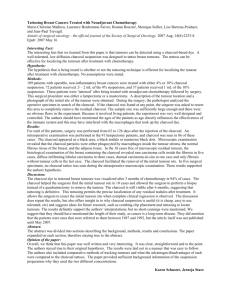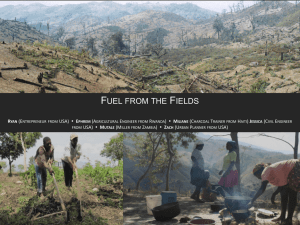Low GHG charcoal production - Meth justification
advertisement
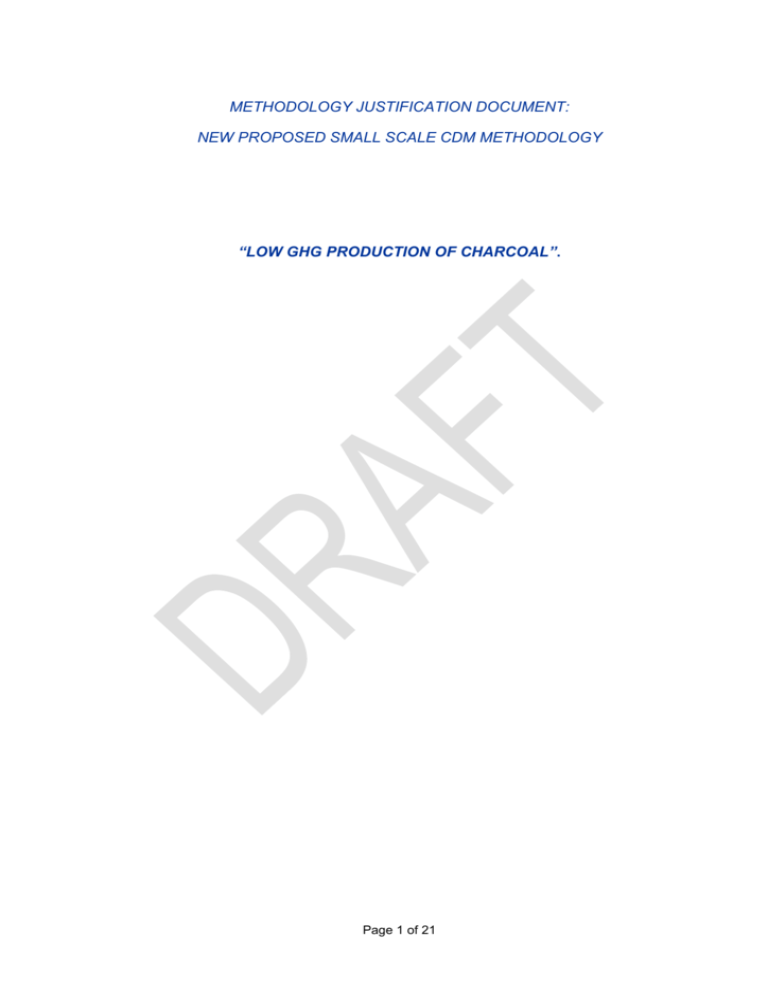
METHODOLOGY JUSTIFICATION DOCUMENT: NEW PROPOSED SMALL SCALE CDM METHODOLOGY “LOW GHG PRODUCTION OF CHARCOAL”. Page 1 of 21 TABLE OF CONTENTS 1. ACKNOWLEDGEMENTS 3 2. HISTORY OF THE METHODOLOGY DEVELOPMENT AND SCOPE OF THE METHODOLOGY 3 INTRODUCTION 4 3.1 Basic problem: 6 3.2 The link between charcoal and deforestation 7 3.3 The opportunity: 7 3. 4. SOURCE, DEFINITIONS AND APPLICABILITY 4.1 5. 8 4.2 Selected approach from paragraph 48 of the CDM modalities and procedures Applicability conditions 4.3 Emission sources 11 4.4 Project boundaries 14 4.5 Identification of the baseline scenario 14 4.6 Additionality 16 4.7 Baseline emissions calculation 16 4.8 Project emissions 17 4.9 Leakage 18 4.10 Monitoring 19 ANNEX 1: OVERVIEW OF FLOWS IN LOW GHG CHARCOAL PROJECTS: Page 2 of 21 8 9 20 1. ACKNOWLEDGEMENTS The justification document was prepared by Nicolas Mueller from Perspectives Climate Change (Zurich), with funding from the DFID Standardised Baseline Project. The inputs from Randall Spalding-Fecher (Pöyry), Daisuke Hayashi and Axel Michaelowa (Perspectives), Anja Kollmuss, Sophie Tison and Christoph Sutter (South Pole Carbon Asset Management) and Sam Bryan (GERES) in this project have been invaluable. In addition to that, credit should be given to the group of methodology experts which has provided very valuable input during the methodology development. Input has been received from the following experts: Gareth Philips, Naoki Matsuo, Felicity Spors, Michael Lazarus and Juerg Fuessler. Many elements which have enabled the discussion on standardised approaches have been made possible by the previous DFID funded assignment “Towards a more standardized approach to baselines and additionality under the CDM”. 2. HISTORY OF THE METHODOLOGY DEVELOPMENT AND SCOPE OF THE METHODOLOGY The overarching goal of the present assignment has been the development of three new CDM methodologies based on a standardised approach for project types with a high relevance to LDCs. Perspectives Climate change has identified the production of charcoal as having both a large potential for emission reductions and a high relevance to LDCs. In turn, Perspectives Climate Change started developing a broadly applicable methodology for the production of charcoal which would also take into account the associated changes in the depletion of forest carbon stocks. A review from the group of methodology experts highlighted the strong expectation to achieve a very strong level of simplicity. In trying to achieve this goal, Perspectives reached the following conclusions: - A higher level of simplicity can be reached for the production of charcoal products from carbon neutral feedstock such as biomass wastes. - The continued use of wood from the depletion of natural forests however requires the determination of project emissions from the consumption of partly non-renewable biomass. As a consequence, it has been decided to develop two distinct methodologies for each of the two project type: Methodology type Standardised methodology for the production of sustainable charcoal and charcoal briquettes Large scale Page 3 of 21 Low GHG production of charcoal Small scale Inputs Biowastes, wood from plantations, pruning of trees, shrubs, bamboos, etc. Same wood mix as in the baseline (partly non renewable biomass) The present document solely serves as justification document for the proposed new methodology “Low GHG production of charcoal”. INTRODUCTION 3. Traditional fuels are widely used in Sub-Saharan Africa, where most LDCs are located as can be seen in the figure below: 100 Cote d'voire Tanzania Traditional Biomass Consumption as % to Total Energy Use (1997) 90 Uganda Malawi Cameroon 70 Ethiopia Burundi Zambia Sierra Leone Niger Kenya 80 Mozambique Zimbabwe 60 Senegal 50 40 30 South Africa 20 Tunisia 10 Morocco Algeria Egypt 0 0 20 40 60 80 100 % Population Living Below $2 a day (1990-2001) Figure 1: Share of traditional fuels (wood and charcoal) as a function of income levels While wood remains the key fuel in most rural areas, charcoal is often the primary fuel for cooking in urban areas. As noted by E.Smeets and al., in 2009 “While information on charcoal use in the region is sparse, available estimates indicate that the fuel provides energy for a majority of urban households.” The following information indicates the share of charcoal as a fuel in urban areas: Page 4 of 21 Table 1: Examples of charcoal use in urban centers Country Share of charcoal as fuel in urban areas Year Source Kenya 80% 2002 (Republic of Kenya, 2002). Tanzania 80% 2003 (Ngerageza, 2003). Ethiopia 97% (urban areas consume 70% of the charcoal in the country 2009 E.Smeets and al. Zambia 85% 2000 (Chidumayo et. al., 2002). In addition, the switch from wood fuel to charcoal in urban areas is well documented as illustrated below: Figure 2: Switch from wood fuel to charcoal in Bamako, Mali, as retrieved from Girard, 2002 In addition, the switch to charcoal will continue at a rate between 4% and 10% per year as found in the literature. At the same time, the further switch to more convenient fuels on the energy ladder is expected to be hampered by high oil prices Figure 3: The energy ladder (source: Sawadogo, A.; August 18, 2008; Women and household energy in Sahelian countries- A BP56 special supplement from PREDAS. As retrieved at: http://www.hedon.info/BP56:WomenAndHouseholdEnergyInSahelianCountries) Page 5 of 21 Improvements in the conversion of biomass to charcoal in Sub-Saharan Africa show a substantial potential for reductions in the associated GHG emissions. This potential consists in both avoided consumption of non sustainable biomass and mitigation of CH4 emissions during the production process. The strong and growing demand for charcoal fuel is an important cause of deforestation. Due to a lack of affordability for other fuel types, a switch to fossil fuels is presently highly unlikely under business as usual. Due to the affordability and convenience domestic consumers of fuels in low income countries are increasingly switching to charcoal, especially in urban areas. The production of charcoal in low income countries is however overwhelmingly dominated by the “informal sector” in which small scale producers use traditional technologies to produce charcoal. Wood is almost always sourced from natural forests and very often harvested illegally, despite forest management systems implemented in some countries. Traditional charcoal making technologies typically lead to high CH4 emissions and commonly require 6 kg of wood per kg of charcoal produced. So far, no CDM methodology has been able to deploy improvements in the charcoal production chain in low income countries at the adequate scale to reduce deforestation, greenhouse gases emissions in the charcoal making and increase energy security. Existing methodologies have so far only focused on the decreased methane emissions (AM0041, AMS-III.K.) and have been complex to apply. Many of the possible options for reducing emissions from an improved charcoal production are presently either not possible to implement or would not gain an adequate amount of CERs compared to their contribution. The purpose of this proposed new methodology is to grant access to carbon markets to high priority projects which strongly reduce GHG emissions in the production of charcoal for low or medium income countries. 3.1 Basic problem: - Charcoal is one of the main fuels in Least Developed Countries especially in Sub-Saharan Africa; - The production and consumption of charcoal leads to a lot of GHG emissions. The high GHG emissions associated with the production of charcoal are the result of three factors: o An unsustainable supply of biomass o The use of inefficient technologies to convert wood into charcoal with yields as low as 10% observed in certain countries (10 kg of wood required to produce 1kg of charcoal). o The use of specific technologies/processes in which the conversion of wood into charcoal leads to a high level of methane emissions. In turn charcoal is one of the most GHG intensive fuels used: Page 6 of 21 Figure 4: net carbon dioxide equivalent emissions per cooking task for various biomass and fuels (from Kammen and Lew) 3.2 The link between charcoal and deforestation Sources of literature confirm charcoal as a source of deforestation. A portion of such evidence is presented in the table below: Table 2: Link between charcoal and deforestation Source Claim with regard to charcoal and deforestation: Kammen and Lew, 2005 (page 5) ...Charcoal production, on the other hand, is responsible for the large scale felling of wood, which may lead more directly to deforestation. GERES – case study (Cambodia), 2011 In Mali, the forests are in continual decline due to drought and largely unrestrained exploitation which are manifested by progressive environmental degradation. Francis Yamba, CEEEZ – case study (Zambia), 2011 Through assessments (ILUA, 2009) evidences of deforestation driven by various factors, one of which is charcoal indicate that annual deforestation rate is between 250,000ha to 300,000 ha. 3.3 The opportunity: Types of opportunities: Opportunities exist to greatly reduce emissions associated with the production of charcoal. These opportunities can be divided in two types: (i) opportunities related to technology and practices for charcoal making and (ii) opportunities related to a decrease in non-renewable share of biomass used. Page 7 of 21 (i) Opportunities related to technology and practices for charcoal making o Low CH4 emitting technologies. o Efficient conversion of biomass to charcoal which leads to biomass savings. For example yields up to 40% can be achieved instead of the 10 to 20% in the baseline. (ii) Opportunities related to a decrease in the non-renewable share of biomass used. Production of charcoal from carbon neutral biomass sources: o Production of charcoal from dedicated plantations (wood, bamboo, etc.). o Production of charcoal briquettes obtained from the carbonization and agglomeration of biomass residues The focus of the present methodology is essentially on related technology and practices. For emission reductions from a decrease in the non-renewable share of biomass used, participants are invited to use the corresponding methodology instead. 4. SOURCE, DEFINITIONS AND APPLICABILITY 4.1 Selected approach from paragraph 48 of the CDM modalities and procedures Approach 48a: “Existing, actual or historical emissions.” This approach is considered the most plausible for the informal charcoal sector as a whole, both for the level of efficiency and the inputs used (wood from natural forests). No autonomous improvements have been observed in the informal charcoal sector as the same ancestral technologies are still in use nowadays and supply the overwhelming majority of the charcoal produced in low income countries. This approach is selected, referring to the “existing, actual or historical emissions” for the whole informal charcoal sector. Although large discrepancies in wood to charcoal yield are observed, an average performance based on a broad set of reliable figures collected is found to be adequate. Approach 48b: “Emissions from technology that represents an economically attractive course of action, taking into account barriers to investment.” This approach is very difficult to apply in practice. Charcoal production technologies in low income countries and least developed countries are the result of a combined opportunity to produce a good with close to zero initial investment and extremely low operating costs, especially when wood from natural forests is sourced for free, either legally or illegally. Small-scale producers from the charcoal sector which form the baseline simply do not have access to finance and increase their efficiency. Even where improved technologies have been externally financed, it has been observed Page 8 of 21 that this “economically attractive course of action” has been discarded1. This corresponds to observation by Kammen and Lew (Kammen and Lew, 2005) noting that “in many countries, the rural people and even charcoal producers are too poor to usecharcoal, and the demand for charcoal is found in the urban areas”. Approach 48c: “Average of similar plants, previous 5 years, in similar economic, environmental and technological circumstances and whose performance is among the top 20% of their category.” This approach is not applicable due to several constraints. The data availability is low and it is unsure how representative the average of the top 20% performers collected would be as it might be dominated by local parameters influencing the performance such as practices. In addition to that, large discrepancies have been observed in the performance level of conversion of wood to charcoal. In turn selecting the average of the top 20% performers creates a too stringent baseline, relying on values which are not representative for the sector. This approach would severely undercut the incentive to reduce emissions under this methodology. 4.2 Applicability conditions The project is the installation and operation of new low GHG charcoal production kilns. A new investment is required to ensure the materiality of the measure. In addition to that, projects eligible under this methodology are intended to replace existing practices characterized by zero-investment or low investment technologies. No existing facility is eligible as project. The methodology is not adequate for replacements and retrofits as no procedure for the determination of baseline emissions for a specific site are included. Instead, the methodology relies on a market based displacement of charcoal which is otherwise produced by the informal charcoal sector. All kilns installed offer a year-round average gravimetric yield (quantity of charcoal per amount of dry wood used) of at least 30%. Only project with a technology able to offer a high yield (kg of charcoal per kg of wood) are allowed. This ensures a high environmental integrity of resulting projects as a high increase in yield leads to a strong reduction in deforestation. The applicability condition excludes the Casamance kiln which is only an “upgrade” of traditional kilns and whose additionality is uncertain as it is the only technology which could possibly be implemented autonomously given its lower cost. This methodology is not applicable for the production of charcoal products derived from biowastes. Quote: „Evidence that local charcoal makers had previously tried several" improved methods was found in the remains of metal kilns and metal pit covers which were scattered throughout the forest.“Source: Feinstein and Van der Plas, 1991, Improving charcoal efficiency in the traditional rural sector. 1 Page 9 of 21 The methodology does not have necessary provisions for this project type. A similar methodology for charcoal projects based on biomass wastes has been proposed. Project proponents are invited to propose and use the methodology developed for charcoal products from biomass wastes. The total emissions reductions must be less than 60,000 tCO2/yr; Standard applicability condition to apply the simplify modalities of the small scale scheme. The project does not supply charcoal to large scale users such as industrial facilities; The supply of charcoal to large scale industries is excluded for the following reasons: (i) the proposed baseline in this methodology is specifically for the production of charcoal from the informal sector; It is very unlikely that large scale users would source their charcoal from the informal charcoal sector; (ii) the inclusion of large scale users such as large scale industries could lead to a dangerous increase in the demand. Project intending to produce charcoal for industrial applications should use the approved methodology AM0082. The project supplies charcoal to one or more identified areas in which charcoal is consumed as fuel for households, small and medium businesses and cottage industries. The charcoal is not supplied to large scale industries. Own applicability condition. The present methodology is only applicable for projects which displace charcoal produced from the informal charcoal sector. Charcoal consumed by households and small scale users in lower income countries is produced by the informal charcoal sector. To ensure the displacement, it has to be ensured that the pool of users is the same as in the baseline. In order to displace charcoal produced from the informal charcoal sector, the methodology requires the supply of the charcoal to an area where charcoal is already consumed. This also ensures that the methodology does not create new pools of charcoal users where only fuelwood was previously used. The project is able to demonstrate that it does not accelerate the depletion of biomass stocks. This can be demonstrated by: The retirement of traditional charcoal making activities on the community level – with the inclusion of workers previously employed in the traditional charcoal production The distribution of efficient cookstoves An afforestation which provides on average a mean annual increment in biomass equal to the depletion by the project. The implementation of a project for the production and use of alternative to wood-based charcoal (e.g. bio-waste based charcoal, introduction of jatropha oil as cooking fuel, etc.) Any combination of the above Page 10 of 21 The project proponent has to make sure that the production capacity installed by the project does not lead to deforestation due to an increased charcoal production. In turn, options are proposed to (i) ensure that either the new production capacity replaces an existing one, (ii) compensate by mitigating the consumption of charcoal whether by fuel switch or energy efficiency at the end user or (iii) compensate the deforestation resulting from the project. 4.3 Emission sources For the project activity, participants should account for the following elements: - Emissions from the use of non-renewable biomass - Emissions from the pyrolysis gases - Emissions from the use of electricity The following rationales have been used to decide on the inclusion of emission sources: Source Electricity consumption Gas Included? CO2 CH4 No No N2O No CO2 CH4 No No N2O No Auxiliary fuels CO2 Baseline CH4 N2O Yes Yes Justification / Explanation The baseline only consists in pit kilns and earth kilns which are generally built on the site of the wood harvest. Such kilns never have an associated electricity consumption. It is safe to assume that number in the baseline and derived from the consolidated GHG database for the informal charcoal sector are from earth mound kilns and earth pit kilns without associated electricity consumption Assumed negligible. The objective reached with charcoal is the production of a convenient fuel which unlike commercial liquid fuel is affordable to households. The quantity of expensive auxiliary fuels is assumed to be either non existing or negligible. Included both for direct CO2 emissions and CO2 from the oxidation of the emitted CO. Included – this is a major source of emissions. Excluded for simplification. Overall, project kilns if at all, will result in lower emissions N2O emissions due to improved processes with sometimes a full combustion of pyrolysis gases. The following average values of N2O emissions per tonne of charcoal have been found in the literature: Smith et al. (1999): 0.0458 g N2O / kg charcoal Brocard et al. (1996): 0.11 g N2O / kg charcoal Pennise et al. (2001): 0.15 g N2O/kg charcoal Carbonization activity No Project activity In turn the average emission factor found from the literature is 0.10 g N2O / kg charcoal, or an equivalent of 0.03 tonne CO2e / tonne of charcoal. Transportation related emissions CO2 CH4 N2O No No No As a comparison, around, in the present status of the consolidated GHG database for the informal charcoal sector, around 4.20 tCO2e are emitted from the informal charcoal sector if 50% of the biomass is from non renewable sources and 7.67 tCO2e are emitted if 100% of the biomass used is from non renewable sources. Determined to be very small. An evaluation of the transportation related emissions can be found in the following table Page 11 of 21 CO2 CH4 No No N2O No CO2 Yes CH4 Yes N2O No CO2 Yes CH4 No N2O No Auxiliary fuels Carbonization activity Power consumption Similar to the baseline, this source is assumed to be very small. From the corresponding preliminary assessment, it has been established that auxiliary fuels represent around 0.2% of the total emission reductions, thus can be neglected. It is highly unlikely for the consumption of auxiliary fuels (non wood based fuels) to increase compared to the baseline as their cost is high compared to the value of charcoal. Yes – as part of the inputs is from non-renewable biomass, this is the major source of project emissions. Included – depending on the technology this may be an important source of emissions in the project. Excluded for simplification – this source of emissions is considered to be very small (as already demonstrated in the baseline) and only lower than the baseline in the project due to the use of more advanced technologies. To be considered in leakages. Depending on the technology, this source of emissions might be important. This source of emissions is assumed to be very small. This source of emissions is assumed to be very small. Transportation related emissions: Unlike pit kilns and earth mound kilns which are built on the site where wood is harvested, the biomass under this methodology will be converted in a fixed kiln. This means that the biomass has to be brought to the charcoal production facility. Compared to the baseline, this represents an increase in project emissions. In the following, the relative impact of transportation related emissions is evaluated. The following data is used: Table 3: Assumptions used for the calculation of the transport related emissions Item Value Charcoal production: 1,000 Biomass conversion yield: 33.3% Corresponding biomass input: 3,000 Density of diesel fuel: Emission factor of diesel fuel Truck capacity (tonnes) Fuel consumption (l/km) Unit Source tonnes per year (assumption) % (assumption - based on the Pronatura project) tonnes per year Calculated 0.89 t/m3 IPCC 2006 0.865 tC/t IPCC 2006 Average distance to the biomass source 50 km (100 km round-trip) 5 9 16 0.167 0.223 0.308 0.444 28 12 4 1 27 Truck capacities and corresponding fuel emission factors are taken from the report “India Road Transport Service Efficiency Study, World Bank South Asia Regional Office” To evaluate the relative share of transport emissions in the project, we use the following values mostly derived from the consolidated GHG database for the informal charcoal Page 12 of 21 sector to evaluate the relative impact of transport emissions to the overall baseline emissions: Table 4: Assumptions for the calculation of baseline emissions Item Value Charcoal production: 1,000 Unit Source tonnes per year (assumption) Correction factor for carbon content 0.66 t charcoal / t standard charcoal (conservative assumption based on the Pronatura project) Equivalent standard charcoal 667 t standard charcoal per year Calculated Emission factor for CO2 emissions (assuming 100% Xnrb) 6.95 tCO2e / t standard charcoal Consolidated GHG database for the informal charcoal sector Xnrb – Fraction of non renewable biomass 50% % Assumption tCH4/t standard charcoal Consolidated GHG database for the informal charcoal sector tCO2e/tCH4 IPCC 2006 Emission factor for methane emissions for the informal charcoal sector 0.034 Latest IPCC global warming potential of methane 21 From the values in the table above, the following value is obtained for baseline emissions: BL=2,799 tCO2e/y. The resulting ratio of transportation emissions compared to baseline emissions is provided in the table below: Table 5: Estimated share of project transportation emissions to baseline emissions Truck capacity (tonnes) Fuel consumption (l/km) Average distance to the biomass source 50 km (100 km round-trip) 5 9 16 27 0.167 0.223 0.308 0.444 1.0% 0.4% 0.1% 0.0% It appears in turn that transportation related emissions would not exceed the 1% threshold even if very small trucks (5 tonnes capacity) are used over long distances (50 km and above). This is however unlikely due to the transportation time required. Project proponents will on the contrary tend to locate their kiln where large amounts of biomass are available and source biomass around the charcoal production facility. In turn, the likelihood for transportation related emissions to exceed the threshold of 1% is extremely small. Not credited emission reductions: Projects under this methodology lead to a reduction of deforestation as less trees have to be cut to produce charcoal. (i) This methodology only credits emission reductions from the carbon saved in the wood which would have been used for charcoal production. Page 13 of 21 (ii) (iii) The total carbon stock of a tree (which is cut for the production of charcoal) exceeds however by at least 20%2 the carbon stock of the wood which would be used in the charcoal production3. In turn, this methodology avoids the total loss of the tree carbon stock4 (by avoiding the cutting of the tree) yet only credit a certain share of this tree carbon stock. As a consequence, real emission reductions are well in excess of the CERs generated. 4.4 Project boundaries The spatial extent of the project boundary encompasses all charcoal production facilities included in the project. This includes among others the carbonization units included in the project as well as areas for storage, processing, bagging and weighting of inputs (wood mix) and outputs (charcoal). The sole production site is included in the project boundary as changes in emissions result from the production of improved carbonization units compared to the baseline. 4.5 Identification of the baseline scenario This standardised additionality test is one of the important innovations proposed in the methodology, and builds on the recent history of special additionality guidance for LDCs. Similar to the EB Guidance on micro-scale additionality, this test allows for automatic additionality in socio-economic settings where it is extremely likely the charcoal consumed by end-users would be produced by the informal charcoal sector using earth mound kilns and pit kilns. The methodology only proposes one baseline scenario (identified as CC1) and is only applicable if this baseline scenario is identified as the most plausible: CC1: The baseline scenario is the production of charcoal from the informal charcoal sector Globally, it has been observed that for all countries with a low income level, wood resources and high costs for modern fuels, there is only one likely baseline which is the production of charcoal by a pool of small-scale producers using similar the same technology, practices, the same input and producing the same output. For this reason, the baseline determination procedure mostly focused on the identification of economic parameters which drive the existence of an informal charcoal sector. Indeed it has been observed that under the present situation of poverty and high prices of modern fuels the existing demand as well as added demand for charcoal is Table 4.4 „Ratio of below-ground biomass to above-ground biomass” of the IPCC Vol. 4 on “Agriculture, Forestry and other Land Use” puts the ratio of biomass in the root system between 20% and 56% for tropical and subtropical climate systems where most of the eligible countries for this methodology are located. 3 Typically, only stems above knee high and branches with over 2 cm in diameter are used in the production of charcoal. The associated carbon stock in small branches, leaves, the lowest part of the stem and roots represents more than 20% of the wood harvested for charcoal. 4 With the exception of deep roots which are expected to partly fossilize. 2 Page 14 of 21 overwhelmingly supplied by small scale producers operating traditional kilns such as earth mound kilns and earth pit kilns. For example, close to 100% of the production observed in 2011 in Cambodia was from traditional kilns with only one single industrial producer of charcoal in the whole country. Similarly in Zambia, 100% of the production was estimated to be from earth mound kilns. In Mali, the production was estimated to be over 90% from traditional kilns. Overall no “modern efficient” charcoal making technologies have been found in low income countries unless supported by a specific programme with only very few exceptions. This means that no autonomous market penetration of efficient technologies has been found. Past efforts to introduce more efficient technologies have for example failed as can be seen from abandoned kilns installed under such programmes in African countries5. The example of Brazil and Thailand which enjoy a higher GDP per capita show the switch to modern fuels, a more modern charcoal production chain which is no longer dominated by inefficient technologies as well as a decreased pressure on forest from charcoal production. Empirical evidence can be used to show that in low income countries, charcoal is the most affordable and convenient fuel and that the charcoal sector is overwhelmingly dominated by small scale producers. It can be demonstrated that charcoal making is a subsistence activity and that for such entities; no switch to modern technologies is likely, unless supported by specific programmes. Evidence for the informal sector being the adequate default baseline for least developed countries, special underdeveloped areas and areas with observed poverty is detailed in the table below: Table 6: Adequacy of the baseline for countries in which the baseline scenario CC1 is assumed to be the most plausible: Baseline alternatives in AM0041: Rationales for the exclusion of the baselines and justification of their exclusion: Adoption of minor efficiency upgrades / refurbishments / improvements of carbonization kilns that are readily available. Literature: Development and adoption of technology or process innovations or improvements that limit methane emissions from kilns. Literature: - This option is only viable for stationary kilns. The projects under this methodology replace the earth mound kilns and earth pit kilns which are built on the harvest site and discarded after only a couple of weeks. Existing kilns can only be improved in the form of adding a chimney on earth mound kilns to turn them into Casamance kiln. The corresponding investment of $200 associated with barriers prevent however this switch to happen under business as usual. - Eligible countries for this methodology do not mandate efficient technologies or enforcement has been much lower than 50% as demonstrated by the dominance of earth pit kilns and earth mound kilns. Quote: „Evidence that local charcoal makers had previously tried several" improved methods was found in the remains of metal kilns and metal pit covers which were scattered throughout the forest.“Source: Feinstein and Van der Plas, 1991, Improving charcoal efficiency in the traditional rural sector. 5 Page 15 of 21 In general, LDCs and areas affected by poverty have a low level of enforcement of laws. - No improvements are possible as kilns are built adhoc on the site of wood collection and discarded afterwards. For this reason, improvements cannot pay off without the switch to a sedentary production site. Aggregated barrier analysis from the literature: - Investment barrier: lack of affordability of efficient kilns (at €500, even an Adam Retort kiln costs the equivalent of the average income of an average charcoal maker). - Insufficient return on investment without CDMrelated income: Without CDM, the only possible savings for charcoal producers comes from the improved ratio between the wood required (cost) and the charcoal sold (profit). In the absence of an enforced fee for wood collection, the cost of harvested wood is low. In turn, the decreased cost in wood collection is not sufficient to make the project attractive without CDM. - Practice barrier: The practice for charcoal maker is to create kilns at the harvest site. These kilns are discarded afterwards as the charcoal makers starts harvesting a new area. - Common practice: charcoal making is hugely dominated by the production of charcoal from wood. The production of charcoal from alternative sources of biomass from biomass residues or plantations has nearly not been observed and is only the result of specific supported efforts. It should be noted that the procedure allows for an automatic additionality determination in specific countries provided that evidence can be produced to support the claim of baseline CC1 being the most plausible baseline scenario. 4.6 Additionality Projects are deemed additional if it can be proven that the baseline CC1 is applicable. A switch to a more sustainable charcoal production has not been observed in the set of eligible countries without supported efforts. 4.7 Baseline emissions calculation Baseline emissions are calculated based on a standard average value of dry yield for charcoal production in low income countries and calculated as follows: BE y QCCP ,PJ ,i y CFNCV ,i , y f NRB ,BLwood , y K CO2 K CH 4 GWPCH 4 , y i Where: BEy QCCP,PJ,i,y = Baseline emissions in year y (t CO2e/yr) = Produced quantity of charcoal product i in year y (t CO2e/yr) Page 16 of 21 CFNCV,i,y fNRB,BL,wood,y KCO2 KCH4 GWPCH4,y = Correction factor for the project to baseline net calorific value of charcoal product i in year y (-) = Fraction of biomass of type i used in the absence of the project activity in year y that can be established as non-renewable biomass using survey methods = Emission factor for CO2 emissions as found in the consolidated GHG database for the informal charcoal sector (tCO2e/t standard charcoal) = Emission factor for methane emissions as found in the consolidated GHG database for the informal charcoal sector (tCH4/t standard charcoal) = Latest IPCC global warming potential of methane (tCO2e/tCH4) In order to allow for the calculations in this methodology to be based on the same level of service in the project and in the baseline, the project output is used and corrected for the baseline to project ratio of net calorific value of charcoal products. Procedures to correct for the net calorific values can be found in annex 2. The reference net calorific value used is provided in the “consolidated GHG database for the informal charcoal sector” in order to ensure consistency with other factors provided and sourced from the same data collection. Two types of emissions are taken into account: - CH4 emissions from the pyrolysis gases. Such emissions are derived from the factor KCH4 - Emissions from the use of non-renewable biomass. These emissions are derived from the factor KCO2. This factor KCO2 represents the average level of emissions resulting from the use of 100% non renewable biomass to produce one tonne of charcoal with the average yield observed for the informal charcoal sector. The figure is therefore multiplied by the fraction of biomass which sourced from non renewable sources in the baseline. Both emission factors shall be taken from the “consolidated GHG database for the informal charcoal sector”. The database derives the numbers from one of the most complete collection of tests performed in countries representative of those eligible under this project. Due to the larger number of performance tests collected, figures from the database are thought to be generally robust and representative. 4.8 Project emissions The project emissions will mostly depend on the quantity of biomass used (calculated from the yield and the project quantity of charcoal) as well the share of this biomass which is from non-renewable sources. In addition to that methane emissions from the pyrolysis process are taken into account. f NRB,PJ, j,k,y 44 PE y QCCP ,i , y CCi EFCH 4, PJ , j ,. k , y 12 k Yield PJ , j ,k , y - Methane emissions are to either use a default value. o If a destruction of the methane formed in the pyrolysis process can be demonstrated, an assumption of 90% of the value of KCH4 is to be used. Such destruction can be assumed in certain retort kilns as well as systems which use the pyrolysis gases productively for the purpose of power generation. The default value of 0.9 for flaring efficiency is commonly used in the CDM and is for example used in AMS-III.H. for CFEww (capture and flare efficiency of the methane Page 17 of 21 recovery and combustion equipment in the wastewater treatment). This is conservative as the value taken as a basis for KCH4 is for traditional kilns which is the least controlled pyrolysis process. The more efficient systems mandated in the project (minimum efficiency of 30%) will already have a much lower specific methane emission factor than KCH4. In turn, the calculation over-estimates project methane emissions before their abatement. o If no methane abatement is claimed, the basis for the calculation of project emission from pyrolysis methane is KCH4. As already explained, this default value is for the least advanced and most methane emitting units as found in the informal charcoal sector. This means that when used in the project, especially for more advanced carbonization units, the value is highly conservative. 4.9 Leakage Power consumption related leakages are considered as advanced types of kilns might consume electricity. It is either calculated based on the consumed electricity or as a default conservative share of baseline emissions. (i) Calculation based on the monitored electricity consumption Emission factor: The default conservative emission factor of 1.3 tCO2e/MWh as found in the latest version of the “Tool to calculate baseline, project and/or leakage emissions from electricity consumption” is applied. This is adequate the specific power consumption is expected to be relatively small. Consumed electricity: The metered yearly electricity consumption per kiln is used. (ii) Electricity related leakages based on a conservative assumption Under this approach, emissions from the consumed electricity are conservatively assumed to be much smaller than 5% of the total baseline emissions. In turn, LEEC,k,y can be calculated as follows: LE EC ,k , y 0.05 BE y This conservative default value of 5% is derived from the table below: Table 7: Adequacy of the 5% standardised discount factor to account for power consumption Item Charcoal production: Value 1,000 Unit Source tonnes per year (assumption) Correction factor for carbon content 0.66 t charcoal / t standard charcoal (conservative assumption based on the Pronatura project) Equivalent standard charcoal 667 t standard charcoal per year Calculated Emission factor for CO2 emissions (assuming 100% Xnrb) 6.95 tCO2e / t standard charcoal Consolidated GHG database for the informal charcoal sector Xnrb – Fraction of non renewable biomass 50% % Assumption Page 18 of 21 Emission factor for methane emissions for the informal charcoal sector 0.034 Latest IPCC global warming potential of methane 21 Total baseline emissions 2799 tCH4/t standard charcoal Consolidated GHG database for the informal charcoal sector tCO2e/tCH4 IPCC 2006 tCO2e / year Calculated from items above Nameplate capacity of motors 10 kW (based on the Pronatura project) Utilization factor 80 % Assumption Hours per year 8769 Emission factor 1.3 Resulting power consumption related leakages Ratio of power related leakages to baseline power consumption 91.1 3.4 h/y tCO2e/MWh tCO2e/y Calculated from the lines above % Calculated on the basis of the determined 91.1 tCO2e/y and calculated baseline emissions of 2799 tCO2e/y The project presented above is for the use of alternative types of biomass in a small kiln. The power consumption is expected to be in all likelihood almost always lower than the share of 3.4% of the baseline emissions for the following reasons: - The emission factor of 1.3 tCO2e/MWh is conservative. - The use of a very small scale project (barely 2 tonnes of charcoal produced per day) for mechanized charcoal units is conservatives. No smaller facility has been observed to consume power for the production of charcoal. Most mechanized units will in all likelihood present lower specific power consumptions with more efficient and larger charcoal production facilities. - The example used is for a project in which the biomass input has to be shredded and the output needs to be agglomerated. Most kilns are likely to use inputs and outputs which do not need to be shredded and then agglomerated but instead directly for blocks of charcoal (e.g. cocounut husks, bamboo, wood, etc.) The application of a discount factor representing 5% of baseline emissions is very conservative as it overestimates leakages by 1/3rd. 4.10 Monitoring This methodology relies on an extremely simple monitoring. Since the methodology prevents the use of other biomass inputs than carbon neutral biomass sources, the methodology does not require the monitoring of the type and quality of the biomass used. The conversion efficiency in this case does not need to be calculated. The incentive to adopt efficient technologies remains in order to maximize the project output (thus CER generation) compared to the biomass sourced. Page 19 of 21 5. ANNEX 1: OVERVIEW OF FLOWS IN LOW GHG CHARCOAL PROJECTS: Biomass input Reduction in carbon stocks associated with non-harvest biomass in deforested areas (branches, leafs, etc.) Charcoal output By-products, wastes and emissions Water content in wood Mass of wood input Baseline Mass of dry biomass R carbon Non renewable fraction (e.g. 50%) NR carbon Mass of charcoal Non emitted carbon (tar, ash, brands, condensables, etc Carbon in charcoal (85% mass) Non renewable fraction (e.g. 50%) Carbon not embodied in charcoal Water content in wood Mass of wood input Project Carbon in charcoal (85% mass) NR R carbon carbon Non renewable fraction (e.g. 50%) Mass of dry biomass Non renewable fraction (e.g. 50%) Mass of charcoal Non emitted carbon (tar, ash, brands, condensables, etc Carbon in charcoal (85% mass) Yield= (Mass of charcoal / mass of wood input) Page 20 of 21 Carbon not embodied in charcoal Page 21 of 21

